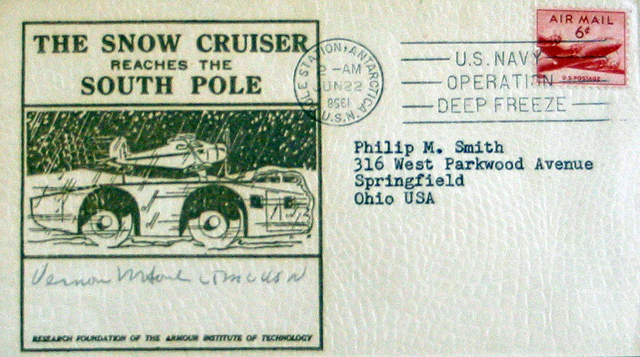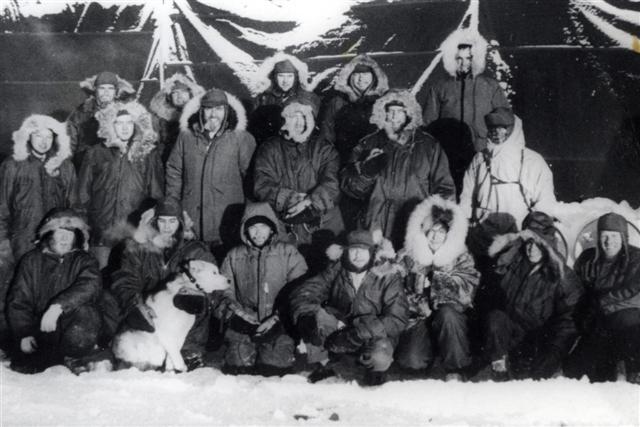Special deliveryAntarctic post offices have long history of servicePosted October 15, 2010
Present-day postal operations at the U.S. Antarctic Program's South Pole and McMurdo stations That wasn’t always the case. The United States established the South Pole Station during the 1956-57 austral summer, the second year of Operation Deep Freeze, the military support facet of the International Geophysical Year “I didn’t really have a post office per say,” said Earl Johnson, a Navy Seabee who took over postal operations at the South Pole in December 1956 from the station’s first postal clerk Bob Chaudoin. There really wasn’t a system for sending letters home, according to Johnson. There was no money and no stamps at the South Pole in 1957, when a first-class letter would have cost 3 cents. With the 1957 winter closing in, bringing months of isolation, Johnson resorted to using Sailor’s Mail. In lieu of postage, the Navy utilities man-turned-postal clerk would write “sailor’s mail,” which the officer in charge would sign, sending it on its way. “That’s what we did to some letters,” recalled the 76-year-old Johnson, now retired in Florida. Mail delivery was also a little unorthodox in those days. Navy planes often airdropped mailbags to the station. Johnson recalled one particular airdrop in which a heavy scientific instrument had been placed inside the mailbag. “That weight tore out the bottom of the bag. There was mail all over the cotton-pickin’-place,” he said. A few days later he spotted the station’s mascot, a cantankerous husky named Bravo, with a piece of paper in its mouth — a letter from Johnson’s fiancé. “You could see where the dog chewed on the envelope,” Johnson said. The ad hoc South Pole postal operation wasn’t the first on the Ice. 
Photo Credit: Peter Rejcek
Cover from the South Pole during the IGY. Note the upside-down year on the cancel.

Photo Credit: Cliff Dickey/Antarctic Photo Library
Bravo, the mail-chewing dog at South Pole in 1957. Such pets are no longer allowed in Antarctica.
That honor goes to Argentina, which established the first post office on Laurie Island in the South Orkney Islands (Islas Orcadas del Sud) in 1904, according to Hal Vogel, a polar philatelist and historian with the American Society of Polar Philatelists Originally a meteorology station established by William Bruce during the Scottish National Antarctic Expedition a year before, Orcadas Base became the first permanent station in that region of the Antarctic Peninsula. The post office canceled mail in 1904 and 1905, with a nearly 40-year hiatus. Postal operations resumed in 1942. “It’s the longest, continuously operated post office in the Antarctic,” Vogel said. Naturally, Adm. Richard E. Byrd, America’s eminent polar explorer, founded the first U.S. post office, during his second Antarctic expedition at Little America II on Oct. 6, 1933. The post office itself was part of a philatelic project supported by President Franklin Delano Roosevelt, an avid stamp collector, according to a history of the Little America Post Office Roosevelt told Byrd it would be nice if stamp collectors around the world could have a commemorative cancellation from a U. S. post office during Byrd’s upcoming expedition. He also suggested a special postage stamp for use only on Little America mail. Roosevelt himself suggested the stamp design, a vertical, navy blue and white stamp that featured a large globe showing several Byrd flights. The 3-cent Byrd Antarctic Expedition II commemorative stamp was issued October 9, 1933, according to the USPS history. It was intended solely for philatelic use on mail sent to Little America. To offset the cost of transportation, which could only be provided by the expedition, a 50-cent surcharge was added to the price of the stamp. The cost did not discourage sales, however, as an estimated 240,000 letters went through the Little America post office. The original Little America postmaster, Leroy Clark, struggled with the job, canceling only a few thousand envelopes. The Post Office Department eventually sent Charles F. Anderson, a 43-year postal veteran who specialized in canceling first-day covers to finish the job. The South Pole Station post office is the longest running one for the USAP, followed by McMurdo Station, which took over the postal duties from Little America V in 1958. A third post office operated at Byrd Station. [See previous article: Byrd history.] Today, two U.S. post offices continue to operate in the Antarctic, one at McMurdo Station and the other at South Pole. Mail is processed through the military postal system, though civilians actually work at the two offices. The McMurdo post office is staffed by full-time employees during the summer, led by postmaster Kathleen Soutter. Philatelic mail from Antarctica is still popular, Soutter said. And while the Internet and electronic mail has certainly cut down on letter mail, online shoppers keep the department busy, processing nearly 95,000 pounds of incoming mail. South Pole relies on volunteers trained by the pros in McMurdo for its postal services. “The cool thing about Pole’s post office is that it’s very community-oriented,” said Beth Watson, former South Pole Station Support supervisor for the USAP who oversaw the all-volunteer post office. Return to main article: Stamp on History. |



For USAP Participants |
For The Public |
For Researchers and EducatorsContact UsNational Science FoundationOffice of Polar Programs Geosciences Directorate 2415 Eisenhower Avenue, Suite W7100 Alexandria, VA 22314 Sign up for the NSF Office of Polar Programs newsletter and events. Feedback Form |


